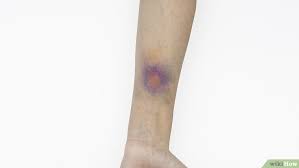Learn how to bruise yourself
There are skins which are more fragile than others and which react even to the slightest shock.
If you want to prank someone and show them the multiple bruises all over your body, there’s no need to torture yourself.
A little makeup should do the trick.
Know how to get a bruise
There are all kinds of skin that react differently.
Indeed, some people will bump quite violently and will not have a mark while others will brush against something and will have their arm all blue.
In fact, if you’re looking for how to bruise yourself for some reason, it’s best to fake it.
There is a special product sold in disguise shops that make perfect bruises, they look like real ones, but be careful, follow the instructions carefully!
How to get a bruise with Make-Up
- Get eyeshadows in different dark shades. A dark eyeshadow applied to the skin can allow you to create a rather realistic bruise, as if the affected body part has been hit abruptly. Secretly borrow your mom’s eyeshadow palette or ask her permission.
- If you want the bruise to look real, try a combination of dark blue, dark purple and even black to get the desired result.
- Makeup should be matte, not bright. If the bruise is shiny, it won’t look real.
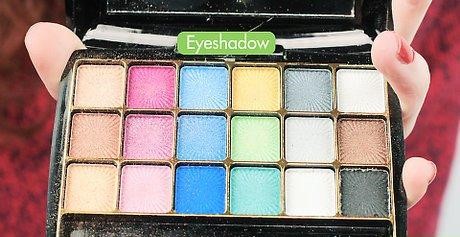
- Dip the bristles of a brush. Moisten the brush and coat it with a thin layer of eyeshadow.
- Gently apply makeup to your skin. In the beginning, it is important to proceed slowly and with a light hand. You can always add more product later. Work the makeup into your skin in a circular fashion, blending as you go.
- Smaller fake bruises usually have a more realistic appearance. The size of the bruise should be about the size of two coins.
- Brush the edges of the bruise to make the makeup smudge slightly and make it look realistic. Don’t overdo it, or it will look fake.
- Add details. Based on the story you want to tell to explain how you got hurt, you should add some detail to the bruise to make it realistic. You can create nicks, scratches or further color it.
- Once you have achieved the desired color with the dark eyeshadow, try applying red blush around the edges to make it appear that the skin is inflamed and red. You will give the impression that it is a peeling caused by a rough surface.
- If you want it to look like an older bruise, apply a splash of yellow eyeshadow around the edges.
- The cuts are usually more difficult to make. If you want to give it a try, use a thin-tipped red marker.
How to get a bruise with Body Paint
- Get a palette of sweat-resistant greasepaint or body paint products. If you want to create an even more realistic-looking bruise, these products are for you. When you buy a simple color palette, you’ll have plenty of options for making bruises so lifelike they’ll be believable to anyone.
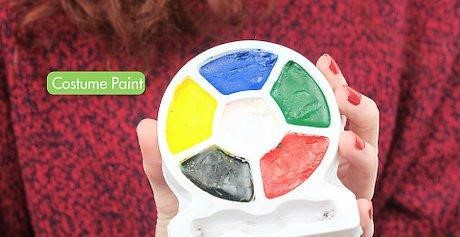
- Use a makeup sponge. Most greasepaint and body makeup palettes come with make-up sponges, not brushes or other applicators. It is an ideal tool for applying these products and creating a realistic bruise.
- If you don’t have sponges, you can use a part of a large, soft, yellow sponge, such as those used for washing cars or for other purposes. Ask your parents if they have a clean one to lend you
- Prepare a surface on which to dab excess product. Take the palette and place it on newspaper, paper towels or other rags that you can dab the sponge on during application. It is important to proceed extremely lightly with these products so that the bruise does not look fake.
- Pick up some red greasepaint with the end of the sponge. Dab one corner of the sponge on a bright, dull red greasepaint. Recent bruises are redder, so this is the right color if you want to make it appear that you have recently injured yourself or that the bruise is quite severe.
- These products are ready to use, although sometimes it is necessary to soften them with water. Always follow the instructions on the package.
- Dab excess product. After picking up some product with the sponge, dab it once or twice on the paper towel or rag you have prepared. You don’t have to overdo it, because in that case it will be difficult to remedy.
- Some professionals use a plastic palette in order to get the right amount of product. If you have one, it will be useful for being able to pick and mix colors.
- Gently tap the product onto the skin. With the sponge, dab it very gently on the spot where you want to create the bruise, following a circular motion. To color the area properly and get a good result, you will only need to tap the product 2-4 times. Be careful not to overdo it.
- The sponge helps you achieve an uneven and mottled result, just as if it were a real bruise below the skin surface.
- Layer with a touch of blue. With another corner of the sponge, pick up a pinch of blue greasepaint and dab a tiny amount on the red layer. Pick up the product with the sponge, dab it on the paper and apply it on the skin as you did before, only in a slightly more delicate way.
- While this step may be strange to you, remember that the skin capillaries sometimes appear blue in some bruises, and then eventually turn dark. A touch of blue will allow you to make it look real.
- Add other colors to make it even more realistic. If you want the bruise to look older, you can apply a small amount of one color on the green or yellow around the outer edges, in the same way as other shades.
- Proceed with an extremely light hand. Sometimes, a touch of red and blue is enough to achieve a realistic bruise. Don’t go overboard with your makeup.
How to get a bruise Using Colored Pencils
- Choose a variety of colors. If you use just one pencil, the bruise will look older and on the road to recovery; instead, if you want it to look more serious, you can use an assortment of colors.
- For the bruise, use gray, dark blue and purple pencils. You can also use graphite rods of these colors.
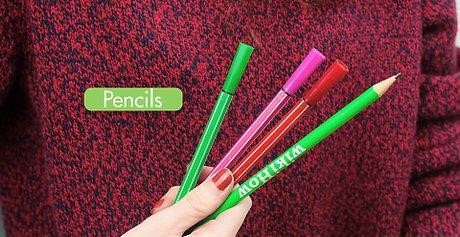
- Draw a circle on a sheet of paper and start coloring it. Using the flat side of the lead, quickly rub it on the paper; press your hand well to create a small pile of colored powder that you can apply on the skin. Though she thinks she has enough, she still continues until she gets a good pile.
- Repeat this process with each pencil, creating a separate pile with each. If you try to make a single circle, the colors will blend and take on a brown tone that will not look realistic.
- Instead of using a regular sheet of paper, rub the pencil on a piece of sandpaper, so you can get some powder without having to waste too much lead.
- Apply the powder to your skin. Pick up some powder with your fingertip and rub it in circular motions on the part you want to make it look bruised. Gently blend the edges to make the bruise more realistic.
- If you use just a little, it will come off pretty easily. Keep scrubbing to make sure it sticks. Make sure you use enough.
- Apply more layers until you get a realistic result. It is usually best to start applying the powder colors and then run a graphite pencil over the bruise to make it as smooth and realistic as possible.
- Start with red-toned powder colors, then start adding darker colors, such as purples and blues, to the bruise. When you’re done, run a graphite pencil across the surface, blurring the edges.
- This step always depends on your skin tone and a variety of factors. Assess your particular situation and experiment until you get a realistic bruise.
How to get a bruise with markers
- Use simple colored markers. Choose some non-permanent marker whose color is similar to that of a real bruise. Dark red, blue and purple are all adequate. Use a brownish yellow (or mix yellow and brown) for the outer edges.
- Make sure you don’t use metallic or glittery markers, otherwise, when you apply them to the skin, the result will obviously be fake.
- Highlighters also make it possible to get a yellow bruise. If you have one, use it instead of a yellow marker.
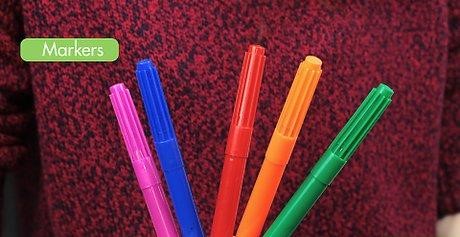
- Start from the center with the reddest color. Draw a small red circle in the center of the spot where you want to make the bruise by applying a very small amount of marker to the skin. It’s easy to make mistakes and end up with the most faux bruise of all time, so proceed with care.
- Create dots of color and then blend them onto the skin. It is not important that the bruise has an appropriate shape right away. You just have to color the skin.
- Add layers of other colors. True bruises are not single-colored, instead they have a variety of inhomogeneous marks. Dab the darker colors on the red to soften it. When applying the other colors to the red layer, proceed by dabbing gently. Once you are done, pass the yellow on the edges, blending everything outwards.
- Blend the colors together. Let the colors smudge to get a shape and color similar to a real bruise. Wet a finger and immediately pat it on the area, blending the colors. This allows you to get a much more realistic result.
How to make fake bruises without makeup
- Pick a good spot. If you want the bruise to look realistic, you need to do it on an appropriate area. Some parts of the body are not prone to bruises, so you need to choose an area that has the right characteristics. Usually, the best places to create a fake bruise are:
- The forearm.
- Anywhere on the leg.
- The forehead.
- The chest or shoulder.
- Do not make a fake bruise near or around the eyes.
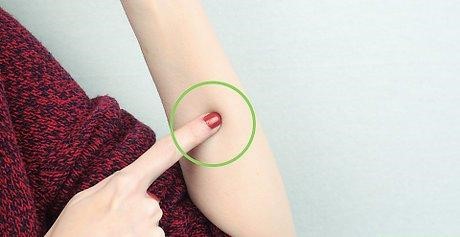
Make the bruise as realistic as possible. The bruise should not be too circular in shape. If it looks like a perfect circle, it will obviously be fake. True bruises are patchy and patchy in shape.
Cover the bruised area. If you want to make someone believe that you have been hurt, you have to put on a little play and not betray yourself. For an effective prank, cover the bruise with clothing or a hat until you are ready to reveal it. Bruises created with graphite pencil are difficult to cover without risking to remove. These bruises are generally okay if you want to show them right away, without dragging the joke along. If you want a longer lasting result, try using make-up products or another technique. Pretend you hurt yourself in the moment. In next article we will discuss about bruise from bug bite.
Also Read: How to Make a Fake Bruise
